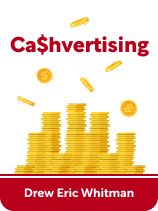

This article is an excerpt from the Shortform book guide to "Ca$hvertising" by Drew Eric Whitman. Shortform has the world's best summaries and analyses of books you should be reading.
Like this article? Sign up for a free trial here.
How should you identify your product’s benefits? After that, how should you effectively market them?
Drew Whitman is an advertising coach and the author of Ca$hvertising, a book that will teach you the fundamental rules of advertising. According to him, to market your product successfully, you must know how it benefits at least one of the eight core needs of human beings.
Read on to learn how to identify your product’s benefits and use them in marketing, according to Whitman.
Identifying Your Product’s Benefits
In his book Ca$hvertising, author and advertising coach Drew Whitman says it’s crucial that you be able to show your product’s ultimate and most important benefit to the consumer. A product’s benefits are the reason customers buy it, so clearly you’ll want to showcase these in your ad.
Importantly, the benefit of a product is different from its functions. Functions are the practical things a product does: clean your windows, for instance, if you sell window cleaner. A benefit is the feeling of happiness, efficiency, or peace the customer hopes to get from the product: the joy of having sparkling windows and knowing these will impress passers-by, for example.
Therefore, in ads, explain to readers how they’ll benefit from your product—how the product will make their lives easier, more efficient, or more enjoyable. Always highlight the greatest benefit to readers first, both in an image and the ad’s headline.
| How to Uncover Your Product’s Benefits: Customer Interviews Whitman recommends showing what your product’s benefit to the customer is, but how do you know what that benefit is? Arguably, a product’s benefit is in the eye of the beholder, and as a product creator or seller you might not know exactly how consumers derive joy or utility from it. One way to determine a product’s benefit is to do customer research. This can be done through customer interviews, email surveys, or focus groups. Interviews are likely most effective in teasing out how a product benefits your customer because the conversational format will likely make consumers more willing to describe their experience using your product in detail. An interview also lets you control the conversation, ensuring the customer doesn’t confuse benefits and functions and simply describe the product’s functions. Finally, a customer interview might also help you pinpoint how best to present your product in your ad’s headline and image. For instance, if your customer says the greatest benefit of your window cleaner is the satisfying squeak of a clean window, you might allude to this in the headline or image. |
Marketing Your Product Effectively
To market your product and showcase its benefits most effectively, Whitman recommends using competitors’ inferior products to strengthen the position of yours. When comparing your product to a competitor’s, be specific about how yours is better: Specificity helps convince the reader you’re right. You can draw a comparison in three steps:
- Warn the consumer of the inferior products other brands are trying to sell them. For instance, you might say: “My competitor will try to get you to believe their cheap light bulbs are just as good as ours.”
- Offer an unconvincing argument in favor of your competitor’s inferior products. This weak argument encourages prospects to perceive the competitor’s product as unacceptable. You might thus say: “Those cheap light bulbs may be fine if you don’t mind irrevocably damaging your eyes.”
- Advocate for your own position and product. This builds on the customer’s existing distaste for the competitor’s product. “But that’s not how we do things at our company. We believe every room should be brightly lit…”
| What If Your Competition Is Too Good to Compare Against? Whitman advises comparing your product’s benefits against your competitor’s so that your product appears superior. But what if your competitor is already using these three steps to compare their product to yours? Or what if your competitors have a top-notch marketing campaign in place that’s difficult to attack? In All Marketers Are Liars, Seth Godin provides some ways to circumnavigate a competitor’s marketing efforts so that you can still compare yourself favorably against them. For example, if the most powerful brand on a market has an unshakeable marketing plan, Godin recommends finding a smaller niche within your market and then comparing yourself favorably against the less prominent brands in that niche. Then, you can use the three steps Whitman recommends. |
Rely More on Either Facts and Figures or Emotion and Positive Association
The next step is to lean on either logic and facts or emotion and positive association, depending on your product’s benefits. People make buying decisions differently, depending on what they’re buying: When purchasing something critical to their livelihoods—a car, a house, and so on—they think logically and based on facts. When contemplating the purchase of something less important—apps, snacks, and so on—they’re guided by emotion.
Therefore, you should consider what kind of benefit your product offers—whether it’s something people need in their lives or simply want for entertainment or enjoyment. If you sell something important, incorporate statistics, testimonials, scientific evidence, and the like into your ad. If you sell something less important, use colors, imagery, humor, and celebrity endorsements.
However, people rarely make buying decisions based exclusively on either logic or emotion. Even if purchasing something insignificant, humans apply logic to ensure they’re getting their money’s worth. By the same token, humans also make important decisions based on emotion. This means that in every ad, include both logical and emotional arguments to some degree, and simply vary the weight you give them.
| Quantifying How Much Humans Use Logic and How Much They Use Emotion Whitman argues that consumers favor either logic or emotion in buying decisions, depending on what they’re buying, but that all consumers use both logic and emotion no matter what. In Way of the Wolf, Jordan Belfort even goes so far as to quantify how much people use logic and emotion. Belfort says that people only use 5 to 10% of their brainpower to form conscious, logical decisions and the other 90+% of their brains to form impressions that lead to emotional decision-making. This stands somewhat in contrast to Whitman’s assertion that people use logic more than emotion when making big decisions. Belfort believes instead that people mostly use emotion to come to a decision but rationalize that decision using logic. It might thus be the case that a homebuyer falls in love with a charming cottage and then rationalizes that love by telling themselves the market is good now, the price is right, and so on. To that end, Belfort encourages salespeople—his target audience—to influence a prospect logically using words and emotionally using tonality and body language. You might apply this principle to your advertising by using copy to rationally persuade a customer to buy your product and images to emotionally persuade them to buy. |

———End of Preview———
Like what you just read? Read the rest of the world's best book summary and analysis of Drew Eric Whitman's "Ca$hvertising" at Shortform.
Here's what you'll find in our full Ca$hvertising summary:
- How to turn your mediocre ads into money-making machines
- 13 techniques to create compelling ads that address customers' needs
- Why fear is a strong motivator that increases sales






